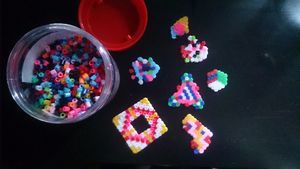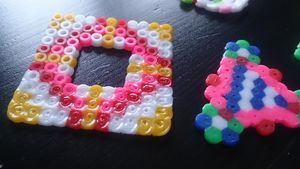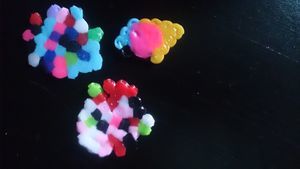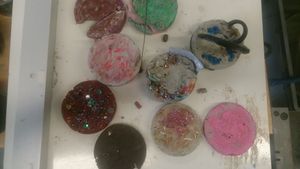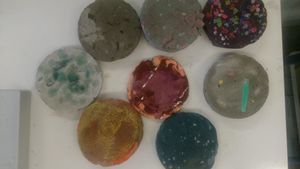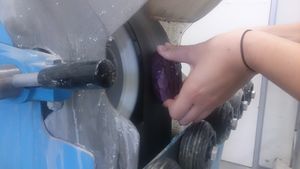Difference between revisions of "User:Lisanne 't Hart"
| Line 75: | Line 75: | ||
We worked in a group of 6 people. Out of the discussion we came to the conclusion that fusing is adding things to things. And we all agree on that. We wanted to experiment with different materials and fuse them together and make tiles out of them. Another day we collected a lot of materials like, nail polish, string beads, plastic, wooden blocks, paint, pencils and a material that look like a sponge. We wanted to melt them together but every material had his own melting temperature. So that seems impossible for now. Lucky we also had cement. So we mixed the cement with the materials in a molt that we made out of a plastic tubes. After this drying proces we wanted to polish them and see what the end result would be. | We worked in a group of 6 people. Out of the discussion we came to the conclusion that fusing is adding things to things. And we all agree on that. We wanted to experiment with different materials and fuse them together and make tiles out of them. Another day we collected a lot of materials like, nail polish, string beads, plastic, wooden blocks, paint, pencils and a material that look like a sponge. We wanted to melt them together but every material had his own melting temperature. So that seems impossible for now. Lucky we also had cement. So we mixed the cement with the materials in a molt that we made out of a plastic tubes. After this drying proces we wanted to polish them and see what the end result would be. | ||
| + | |||
| + | |||
| + | [[File:shared1.JPG|300px||alt text]] | ||
| + | [[File:shared2.JPG|300px|alt text]] | ||
| + | [[File:shared3.JPG|300px||alt text]] | ||
| + | |||
Revision as of 12:54, 23 March 2017
Lisanne ’t Hart
0912081@hr.nl
Major: Graphic Design
Practice: Autonomous - Digital Craft
What is craft?
In the class we discussed what craft is. We came to the conclusion that craft is about every humans ability to make. It comes from a passion were humans explore how to make stuff. Craft is about the proces. Art can be the outcome.
Me and my group has to work with fusing. I looked up what we should do with fusing: “In fusing you will deepen your knowledge different additive fabrication and 3D printing technologies, their different materials and bonding processes, and search for the craft in an industry that marks itself as fast and cheap. So for the first four weeks I will deepen my knowledge and exploring possibilities within fusing.
I will show you 5 samples:
1. Historical example 2. Shared example 3. Comparative example 4. New try-out skill 5. Pushing the material to the limit.
The history of Fusing
To found out what the history of fusing is we first wanted to find out what it is. You can talk about fusing as adding things to things. I discussed with my group what the beginning of fusing was. It become very con-fusing, because we found out that fusing is the beginning of life. To make it not so con-fusing we sticked to the craft part: What is fusing in craft? To make it not so con-fusing I will explain it with an example. Felting is a good example to discuss about what fusing is. Felt from wool is considered to be the oldest know textile. We can speak about 3000 years before christ. Felt is produced by matting, condensing and pressing fibers together. With wet felting you need hot water and soap. And with a movement you make sure that the fibers from the wool stick together. This proces makes it belong to fusing.
Conclusie on what fusing is: Adding things to things.
Text: The invention of craft - by Glenn Ademson"
The term 'craft' is a modern invention in the industrial revolution. (1750-1850) The practice existed already.
1. Historical example
The first material that popped into my head when I heard fusing was “String beads” (Dutch: Strijkkralen). As a child I was always making something nice out of it. I decide it to buy it at a shop and try to make something out of it, now I am not a child anymore I could be interesting. This was the result: I was experimenting to do it without using the pad and just fuse the string beans together with the iron. My opinion is that when I made pattern designed by me that the material got more value. I see this more as an experiment. Maybe I can combine those two things for my end project.
2. Shared example
We worked in a group of 6 people. Out of the discussion we came to the conclusion that fusing is adding things to things. And we all agree on that. We wanted to experiment with different materials and fuse them together and make tiles out of them. Another day we collected a lot of materials like, nail polish, string beads, plastic, wooden blocks, paint, pencils and a material that look like a sponge. We wanted to melt them together but every material had his own melting temperature. So that seems impossible for now. Lucky we also had cement. So we mixed the cement with the materials in a molt that we made out of a plastic tubes. After this drying proces we wanted to polish them and see what the end result would be.
3. Comparative Example
4. New try out skill
5. Pushing your material to the limit.
String beans in the microwave.
Materialising statement on making.
Final + communicative product.
Why I make: The make more value to things.
